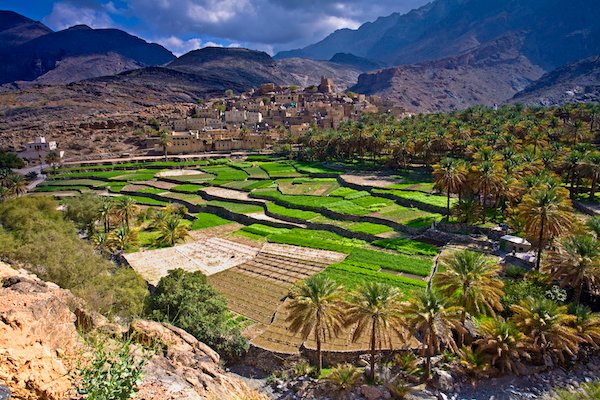Lifestyle
4.25.2022
Oman: a flourishing mountain in the secret of an ancestral technique

In Oman, where more than 80% of the territory is covered by desert, a spectacular field of suspended oases reigns in the heart of the mountains, preserved thanks to an ancestral irrigation technique.
By climbing the Jebel Akhdar, literally the “green mountain”, you will be able to cross about forty villages-oasis. These green landscapes have their own microclimate, conducive to the abundant development of a biodiversity usually specific to the Mediterranean rim. But this region perched in altitude owes its impressive ecosystem to its falaj, a traditional irrigation system allowing the equitable distribution of water. And it has been functioning for over 400 years, winding through the streets, while feeding the crops below.
A thriving garden in the middle of the desert
On the plains of Jebel Akhdar, palm and rose gardens stretch as far as the eye can see, covering half the cliff. Rose water is also born in this region, from a smoked cooking of the petals and then a fine filtering. Pomegranate, peach and apricot trees grow abundantly on the edge of the cliffs and goats, both farmed and wild, continue to populate the mountain. The Jebel remains an oasis from which even the Sultan of Oman orders for his own consumption.

An ecological potential to explore
Naturally rich in water, Jebel Akhdar has a mild climate. At an altitude of 2000 meters, temperatures stabilize at 10°C while in Muscat, barely two hours away by car, the heat often exceeds 40°C.
The prosperity of this place on the side of the mountains comes from a human achievement dug in the rock. Canals capture water from the mountains and the water flows through kilometers of pipes to feed the vegetation and water the villages that make a living from farming and ranching. Going back centuries, guets and rounds are organized in order to monitor throughout the day and night the flow and regulation of water courses. This remarkable irrigation system, which is at least four thousand years old, was classified as a Unesco World Heritage Site in 2006.
popular

